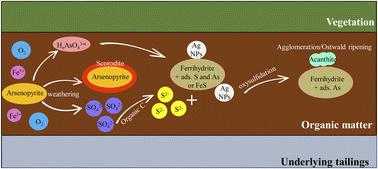当前位置:
X-MOL 学术
›
Environ. Sci.: Processes Impacts
›
论文详情
Our official English website, www.x-mol.net, welcomes your
feedback! (Note: you will need to create a separate account there.)
Nanoscale characterization of the sequestration and transformation of silver and arsenic in soil organic matter using atom probe tomography and transmission electron microscopy
Environmental Science: Processes & Impacts ( IF 4.3 ) Pub Date : 2023-02-02 , DOI: 10.1039/d2em00332e Mozhgan Akbari Alavijeh 1 , Michael Schindler 1 , Mark G Wirth 2 , Odeta Qafoku 2 , Libor Kovarik 3 , Daniel E Perea 2
Environmental Science: Processes & Impacts ( IF 4.3 ) Pub Date : 2023-02-02 , DOI: 10.1039/d2em00332e Mozhgan Akbari Alavijeh 1 , Michael Schindler 1 , Mark G Wirth 2 , Odeta Qafoku 2 , Libor Kovarik 3 , Daniel E Perea 2
Affiliation

|
This study investigates the sequestration and transformation of silver (Ag) and arsenic (As) ions in soil organic matter (OM) at the nanoscale using the combination of atom probe tomography (APT), transmission electron microscopy (TEM), focused ion beam (FIB), ion mill thinning and scanning electron microscopy (SEM). Silver-arsenic contaminated organic-rich soils were collected along the shore of Cobalt Lake, a former mining and milling site of the famous Ag deposits at Cobalt, Ontario, Canada. SEM examinations show that particulate organic matter (OM grains) contains mineral inclusions composed of mainly Fe, S, and Si with minor As and traces of Ag. Four OM grains with detectable concentrations of Ag (by SEM-EDS) were further characterized with either a combination of TEM and APT or TEM alone. These examinations show that As is predominantly sequestered by OM through either co-precipitation with Fe-(hydr)oxide inclusions or adsorption on Fe-(hydr)oxides and their subsequent transformation into scorodite (FeAsO4·2H2O)/amorphous Fe-arsenate (AFA). Silver nanoparticles (NPs) with diameters in the range of ∼5–20 nm occur in the organic matrix as well as on the surface of Fe-rich inclusions (Fe-hydroxides, Fe-arsenates, Fe-sulfides), whereas Ag sulfide NPs were only observed on the surfaces of the Fe-rich inclusions. Rims of Ag-sulfides on Ag NPs (TEM data), accumulation of S atoms within and around Ag NPs (APT data), and the occurrence of dendritic as well as euhedral acanthite NPs with diameters in the range of ∼100–400 nm (TEM data) indicate that the sulfidation of the Ag NPs occurred via a mineral-replacement reaction (rims) or a complete dissolution of the Ag NPs, the subsequent precipitation of acanthite NPs and their aggregation (dendrites) and Ostwald ripening (euhedral crystals). These results show the importance of OM and, specifically the mineral inclusions in the sequestration of Ag and As to less bioavailable forms such as acanthite and scorodite, respectively.
中文翻译:

使用原子探针断层扫描和透射电子显微镜对土壤有机质中银和砷的封存和转化进行纳米级表征
本研究结合原子探针断层扫描 (APT)、透射电子显微镜 (TEM)、聚焦离子束 ( FIB)、离子磨减薄和扫描电子显微镜 (SEM)。钴湖沿岸收集了被银砷污染的富含有机物的土壤,该湖曾是加拿大安大略省钴矿著名银矿的采矿和加工厂。SEM 检查表明,颗粒状有机物(OM 颗粒)含有矿物包裹体,主要由 Fe、S 和 Si 以及少量 As 和痕量 Ag 组成。使用 TEM 和 APT 的组合或单独使用 TEM 进一步表征具有可检测浓度的 Ag(通过 SEM-EDS)的四种 OM 颗粒。4 ·2H 2 O)/无定形砷酸铁(AFA)。直径在~5-20 nm 范围内的银纳米粒子 (NPs) 出现在有机基质以及富铁包裹体(Fe-氢氧化物、Fe-砷酸盐、Fe-硫化物)的表面,而 Ag 硫化物 NPs仅在富铁包裹体表面观察到。Ag NPs 上的 Ag-硫化物边缘(TEM 数据),Ag NPs 内部和周围 S 原子的积累(APT 数据),以及直径在 ~100-400 nm 范围内的树枝状和自形棘石 NPs 的出现( TEM 数据)表明 Ag NPs 的硫化通过矿物置换反应(边缘)或 Ag NPs 的完全溶解,随后的棘石 NPs 沉淀及其聚集(树突)和 Ostwald 熟化(自形晶体)。这些结果显示了 OM 的重要性,特别是矿物内含物在将 Ag 和 As 分别螯合到生物利用度较低的形式(例如棘石和臭葱石)中的重要性。
更新日期:2023-02-02
中文翻译:

使用原子探针断层扫描和透射电子显微镜对土壤有机质中银和砷的封存和转化进行纳米级表征
本研究结合原子探针断层扫描 (APT)、透射电子显微镜 (TEM)、聚焦离子束 ( FIB)、离子磨减薄和扫描电子显微镜 (SEM)。钴湖沿岸收集了被银砷污染的富含有机物的土壤,该湖曾是加拿大安大略省钴矿著名银矿的采矿和加工厂。SEM 检查表明,颗粒状有机物(OM 颗粒)含有矿物包裹体,主要由 Fe、S 和 Si 以及少量 As 和痕量 Ag 组成。使用 TEM 和 APT 的组合或单独使用 TEM 进一步表征具有可检测浓度的 Ag(通过 SEM-EDS)的四种 OM 颗粒。4 ·2H 2 O)/无定形砷酸铁(AFA)。直径在~5-20 nm 范围内的银纳米粒子 (NPs) 出现在有机基质以及富铁包裹体(Fe-氢氧化物、Fe-砷酸盐、Fe-硫化物)的表面,而 Ag 硫化物 NPs仅在富铁包裹体表面观察到。Ag NPs 上的 Ag-硫化物边缘(TEM 数据),Ag NPs 内部和周围 S 原子的积累(APT 数据),以及直径在 ~100-400 nm 范围内的树枝状和自形棘石 NPs 的出现( TEM 数据)表明 Ag NPs 的硫化通过矿物置换反应(边缘)或 Ag NPs 的完全溶解,随后的棘石 NPs 沉淀及其聚集(树突)和 Ostwald 熟化(自形晶体)。这些结果显示了 OM 的重要性,特别是矿物内含物在将 Ag 和 As 分别螯合到生物利用度较低的形式(例如棘石和臭葱石)中的重要性。











































 京公网安备 11010802027423号
京公网安备 11010802027423号